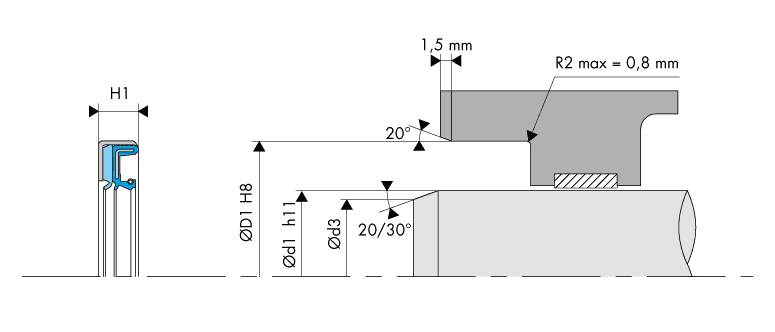BECA 156

Description
The COMB2 profile is a combi seal composed of a metal cage, a TC-TCW shaft seal and a compact polyurethane anti-pollution deflector.
Advantages
Long lifespan
Moderate/high rotation speeds
Small axial displacements
Moderate/high protection against external dirt
Technical data
| Temperature | < 100°C |
|---|---|
| Pressure | 0.05 MPa |
| Speed | 6 m/s |
| Level of pollution | Normal - Moderate |
Applications
Agriculture
Transmissions
Rotations during high levels of pollution
Materials
Rubber
NBR 70 - 75 Shore A
FKM 70 - 75 Shore A
Deflector
PU 92 Shore A
PU 94 Shore A
Metal cage
Steel - AISI 1010
Spring
Steel - AISI 1070 - 1090
Dimensions

Materials
Metal cage - Spring
The table below shows the materials that we can offer for metal cages and springs.
| Application | Material | Standard | Characteristics |
|---|---|---|---|
| Metal cage | Non-alloy standard steel | AISI 1010 (DIN 1624) |
Cold rolled steel |
| Metal cage | Nickel chrome steel | AISI 304 (DIN 1.4301 - V2A) |
Standard stainless steel |
| Metal cage and spring | Chrome-nickel-molybdenum steel | AISI 316 (DIN 1.4401 - V4A) |
Stainless steel highly resistant to corrosion |
| Spring | Steel for springs | AISI 1070 - 1090 DIN 17223 |
Cold drawn carbon steel wire |
| Spring | Nickel chrome steel | AISI 302 (DIN 1.4300) |
Stainless steel for springs with a high carbon content |
Rubbers
ACM (Polyacrylate)
Polymers containing ethyl acrylate (or butyl acrylate) have a small amount of monomer, which is necessary for cross-linking; ACM is a material with better heat resistance than NBR. It is often used for automatic gearboxes.
| Chemical resistance | Mineral oils (motor oils, gear box oils, ATF oils) Atmospheric and ozone agents |
|---|---|
| Compatibility issue | Glycol-based brake fluids (Dot 3 & 4) Aromatic and chlorinated hydrocarbons Water and steam Acids, alkalis and amines |
| Temperature range | -25°C to + 150°C (short-term peak at +160°C) -35°C / +150°C with particular ACMs |
FKM (fluorinated rubber)
Depending on their structure and fluorine content, the chemical resistance and resistance to the cold in fluororubbers can vary. This FKM-based rubber is very often used for high-temperature hydraulics and pneumatics, for industrial valves, injection/fuel systems, motor seals and high-vacuum systems.
| Chemical resistance | Mineral oils and greases, ASTM n°1, IRM 902 and IRM 903 oils. Fire-resistant liquids (HFD) Silicone oils and greases Mineral and vegetable oils and greases Aliphatic hydrocarbons (propane, butane, petroleum) Aromatic hydrocarbons (benzene, toluene) Chlorinated hydrocarbons (trichlorethylene) Fuel (including high alcohol content) Atmospheric and ozone agents |
|---|---|
| Compatibility issue | Glycol-based brake fluids Ammonia gas Organic acids with a low molecular weight (formic and acetic acids) |
| Temperature range | -20°C / +200°C (short-term peak at +230°C) -40°C / +200°C with particular FKMs |
HNBR (Hydrogenated Nitrile Butadiene Rubber)
This HNBR-based rubber is obtained through selective hydrogenation of the NBR's butadiene groups. It is commonly used for power-assisted steering and for air conditioning.
| Chemical resistance | Aliphatic hydrocarbons Mineral and vegetable oils and greases Fire-resistant fluids (HFA, HFB and HFC) Diluted acids, saline solutions and bases for operation at an average temperature Water and steam up to +150°C Atmospheric and ozone agents |
|---|---|
| Compatibility issue | Chlorinated hydrocarbons Polar solvents (ketones, esters and ethers) Strong acids |
| Temperature range | -30°C / +150°C (short-term peak at +160°C) -40°C / +150°C with particular HNBRs |
NBR (Nitrile Butadiene Rubber)
Nitrile rubber (NBR) is the general term for acrylonitrile-butadiene copolymer. The ACN content can vary between 18% and 50%. While the acrylonitrile content is important, the resistance to oil and fuel is more so. Conversely, the elasticity and compression set are not as good. The NBR has good mechanical properties and good wear resistance. However, its resistance to atmospheric agents and the ozone is relatively low.
| Chemical resistance | Aliphatic hydrocarbons (propane, butane, petroleum, diesel fuel) Mineral oils and greases Fire-resistant fluids (HFA, HFB and HFC) Diluted acids, low-temperature alkaline and saline solutions Water (up to +100°C max) |
|---|---|
| Compatibility issue | Fuels with high aromatic content Aromatic hydrocarbons (benzene) Chlorinated hydrocarbons (trichlorethylene) Polar solvents (ketone, acetone, acetic acid, ethylene-ester) Strong acids Glycol-based brake fluids Atmospheric and ozone agents |
| Temperature range | -30°C / +100°C (short-term peak at +120°C) -40°C / +100°C with particular NBRs |
PU (Polyurethane)
Polyurethane is a material that has the elastic properties of rubber. The proportion in its composition (diisocyanate, polyol, chain extender) is determined by its properties. This material is characterised by a strong mechanical resistance, good wear resistance, high elastic modulus, good flexibility and a very good ozone and oxidation resistance.
| Chemical resistance | Pure aliphatic hydrocarbons (propane, butane) Mineral oils and greases Silicone oils and greases Water up to +50°C |
|---|---|
| Compatibility issue | Ketones, esters, ethers, alcohols and glycols Hot water, steam, alkalis, amines and acids |
| Temperature range | -30°C/+90°C -30°C / +110°C with our special PU (+150°C over a short time) |
The table below gives an overview of the physical, chemical and mechanical characteristics for each of the materials.
| Characteristics/Materials | ACM | FKM | HNBR | NBR |
|---|---|---|---|---|
| Abrasion resistant | 2 | 2 | 2 | 2 |
| Resistance to acids | 4 | 1 | 1 | 3 |
| Chemical resistance | 4 | 1 | 2 | 2 |
| Resistance to cold | 4 | 4 | 2 | 2 |
| Dynamic properties | 3 | 2 | 1 | 2 |
| Electrical properties | 3 | 4 | 3 | 3 |
| Flame resistant | 4 | 1 | 4 | 4 |
| Heat resistant | 1 | 1 | 1 | 2 |
| Sealing water | 1 | 2 | 2 | 2 |
| Oil resistant | 1 | 1 | 1 | 1 |
| Ozone resistant | 1 | 1 | 2 | 4 |
| Tearing resistant | 2 | 3 | 2 | 2 |
| Traction resistant | 3 | 1 | 1 | 2 |
| Water/vapour resistant | 4 | 3 | 1 | 2 |
| Resistance to atmospheric agents | 1 | 1 | 2 | 3 |
1. Excellent properties 2. Good properties 3. Average properties 4. Poor properties
Chemical compatibility
A "Chemical compatibility guide" catalogue can be downloaded from the Documentation section. You can also use our online "Chemical compatibility" tool free of charge.
These two tools give you the option of measuring the behaviour of our materials that come into contact with the majority of existing fluids. The data displayed is the result of rigorous testing of the ambient temperature and in consultation with previous publications. Test results are not fully representative due to the specific features of your application. The tests performed actually do not consider additives and impurities that may exist under the actual conditions of use, nor the potential elevation of temperatures. Other parameters can also alter the behaviour of our materials, such as the hardness, persistence, abrasion, etc. We therefore recommend performing your own tests to verify the compatibility of our materials according to your specific application. Our technical team can provide you with any additional information.
Only on request
